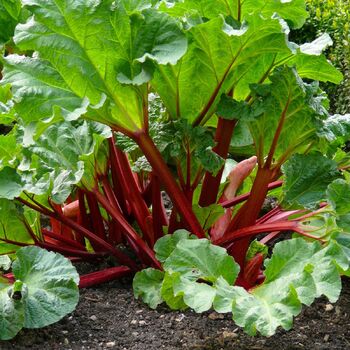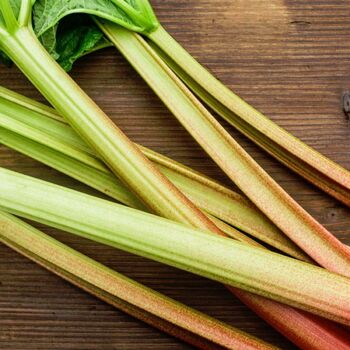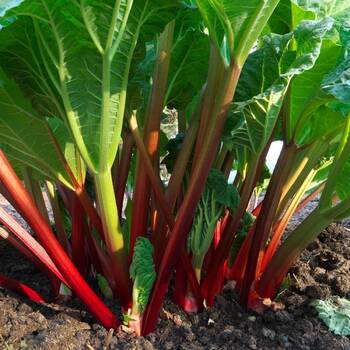
How to Grow Rhubarb Seeds
Grow Guide #2310
Family: Polygonaceae
Binomial name: Rheum rhabarbarum
Life Cycle: Perennial
This 'How to Grow' guide details everything a home gardener needs to know to plant, grow and care for Rhubarb (Rheum rhabarbarum).
(This guide provides instructions on how to grow rhubarb from seed. Rhubarb can also be grown from crowns, the year-old roots and rhizomes of plants that are dug up and sold bare-rooted (without soil). To learn how to grow rhubarb from crowns, click here.)
When to Sow Rhubarb Seeds
Rhubarb is a perennial plant that grows year round in most climates. Use the table below to identify the best time of year to sow rhubarb seeds in your climate.
| JAN | FEB | MAR | APR | MAY | JUN | JUL | AUG | SEP | OCT | NOV | DEC | |
|---|---|---|---|---|---|---|---|---|---|---|---|---|
| Cool | ||||||||||||
| Temperate | ||||||||||||
| Sub-Tropical | ||||||||||||
| Tropical | ||||||||||||
| Arid |
Preparation
Rhubarb plants are perennial, meaning they live for several years. Choose a permanent position where plants can grow undisturbed by regular digging.
Rhubarb plants are best grown in full sun or part shade. Choose a location that will receive at least 3 hours of full sun each day.
Rhubarb plants need a well drained soil enriched with plenty of organic matter. Prepare soil by weeding it thoroughly, digging it over to loosen it and adding aged animal manure or compost. Keep the area free of weeds until planting. Learn more about preparing soil for planting here.
Rhubarb plants can be grown in containers. If possible choose a variety that’s recommended for container growing. Use a good quality potting mix and make sure your container is large enough for mature plants; a minimum of 75 litres is recommended for rhubarb. During the growing season, keep in mind that container grown plants may need additional fertiliser to encourage healthy growth.
How to Sow Rhubarb Seeds
Rhubarb seeds do not require any treatment (eg soaking, stratification) before sowing.
Rhubarb seeds can be sown directly into the garden OR seedlings can be raised in trays or other containers and transplanted to the garden once established.
Sow Direct
- Sow seeds directly in the garden 10mm deep and 50-70cm apart, with rows 70-100cm apart.
- Keep soil moist but never wet or dry.
- Seeds should germinate in around 7-14 days at a soil temperature of 20-23°C.
- Young seedlings will need protection from pests, pets and weather until they are established.
Raise Seedlings
- Fill trays, punnets or jiffy pots with a good quality seed-raising mix, or use soil starter pellets.
- Sow seeds 10mm deep.
- Keep soil moist but never wet or dry.
- Seeds should germinate in around 7-14 days at a soil temperature of 20-23°C.
- Transplant seedlings to the garden once they have their first true leaves and are large enough to handle (usually 5-10cm tall).
- Plant out, spacing plants 50-70cm apart, with rows 70-100cm apart.
How to Grow Rhubarb
Rhubarb plants may need watering during the growing season. Water when the soil is dry about 5cm below the surface (test this by scratching away a little soil with your finger). Water deeply in the early morning or late afternoon. Avoid watering the leaves of plants to avoid fungal diseases. Learn more about watering here.
If soil was well prepared no extra fertiliser should be necessary. In poor soil or to give your plants an extra boost, application of a balanced fertiliser or one formulated for fruit and vegetables can be beneficial:
- Apply slow release fertiliser at the recommended rate when transplanting or when seedlings are 5-10cm tall.
- Apply liquid fertiliser at the recommended rate and frequency while plants are fruiting or flowering.
Tip: To extend the harvest, remove flower stalks as soon as they appear.
Optional: For the strongest plants, do not harvest stalks in the first year of growth.
How to Harvest Rhubarb
Rhubarb should be ready to harvest in approximately 100-140 days.
Rhubarb stalks are ready to harvest when they are large enough to eat. Harvest the outside stalks first, leaving some in the centre of the plant for future growth. Harvest individual stalks by pulling and twisting them gently from the base to separate them from the plant. Cut off the leaves and dispose of them in the compost or green waste. Rhubarb stalks can be stored short term in the fridge. For longer term storage, rhubarb can be canned or frozen.
Warning! Do not eat rhubarb leaves, they are toxic.
Common Problems when Growing Rhubarb
Like all plants, rhubarb is susceptible to some pests, diseases and other problems. Below is a list of the most common problems gardeners encounter when growing rhubarb plants:
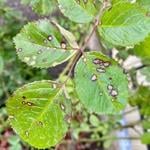 Bacterial leaf spot is a disease that causes irregularly shaped brown spots on all above-ground parts of a plant. The spots at first appear to be wet but become dry and scab-like over time. Leaves and flowers can fall prematurely. Water plants at soil level (not on the leaves), dispose of fallen leaves and fruit and practice crop rotation.
Bacterial leaf spot is a disease that causes irregularly shaped brown spots on all above-ground parts of a plant. The spots at first appear to be wet but become dry and scab-like over time. Leaves and flowers can fall prematurely. Water plants at soil level (not on the leaves), dispose of fallen leaves and fruit and practice crop rotation.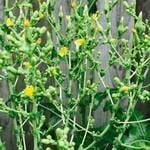 Bolting is when a plant prematurely flowers and goes to seed. Bolting can be caused by a period of extreme weather. Avoid sowing seed until after the danger of frosts has passed or in very hot weather. Water plants regularly and deeply in hot weather to prevent them suffering heat stress.
Bolting is when a plant prematurely flowers and goes to seed. Bolting can be caused by a period of extreme weather. Avoid sowing seed until after the danger of frosts has passed or in very hot weather. Water plants regularly and deeply in hot weather to prevent them suffering heat stress. Slugs and snails are molluscs that feed on tender leaves and shoots, mostly at night, leaving slimy trails behind them. Control them by removing their hiding places, keeping free range poultry, collecting them by torchlight or by placing traps. Read more about slugs and snails here.
Slugs and snails are molluscs that feed on tender leaves and shoots, mostly at night, leaving slimy trails behind them. Control them by removing their hiding places, keeping free range poultry, collecting them by torchlight or by placing traps. Read more about slugs and snails here.


.png)



